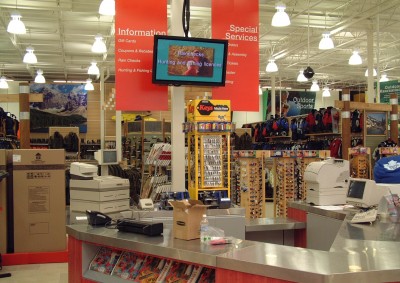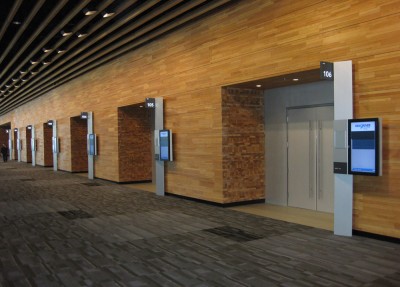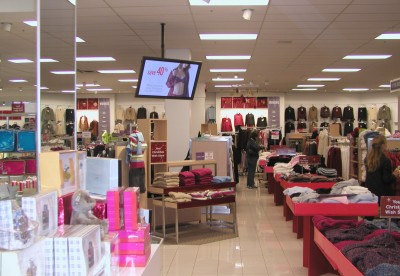Integration with security and safety systems
by Matthew | 18 April 2012 8:47 am
 [1]
[1]Photos courtesy Omnivex
By Doug Bannister
Digital signage is a rapidly growing medium, but securing and managing dynamic displays under an organization-wide information technology (IT) network still often comes across as a difficult challenge for many companies. This is a pity, as the technology behind digital signage is well-positioned to make management easier.
While there are many components that make up a successful digital signage deployment—and careful planning is key—in the end, a single software platform can support a wide variety of applications, including not only typical screen content, but also emergency-response mass notifications, room controls and surveillance footage. Indeed, digital signage is helping to augment security and surveillance systems in a variety of environments, including retail stores, hotels, convention centres and other public facilities.
Combining digital signage with security and surveillance systems is a growing trend that can benefit many users. By integrating a digital signage network under standard IT management, organizations do not have to make large additional investments to support other applications. A single platform means costs can be shared across departments and their messaging can be consistent and simplified, with alerts and notifications appearing in all locations simultaneously.
Watching out for you
This type of integration does not necessarily need to have been pre-planned. In many cases, digital signage has been integrated with existing retail security systems.
 [2]
[2]The Vancouver Convention Centre’s digital signage network connects to its fire alarm system. This way, in case of a fire, the screens can help people evacuate the building by providing wayfinding-based instructions.
After all, it is common for shops to use small TV screens displaying surveillance footage to let customers know they are being watched. Some retailers even try to sell out-of-home (OOH) advertising space on the periphery of these screens, though they are generally unsuccessful.
For a digital signage network to use the video feed from a camera is the same as with any other type of feed to the software, but the major difference is in picture quality. Since security digital video recorders (DVRs) must store many hours of footage, their corresponding surveillance cameras tend to be very low-resolution systems.
That being the case, OOH marketers usually do not want to combine their promotional messages with poor-quality surveillance images and a note saying, “We are watching you!” Some retailers soften the message, suggesting instead the cameras help protect customers, but it is generally more appropriate to flank security footage with such content as their hours of operation and/or a store directory.
Also, not all screens have to run the same content. Surveillance footage only needs to run on a few within a store, usually near the entrance and/or cashier.
Contextual content
Digital signage works best when it delivers contextual visual information based on live events and current information. Content, therefore, should change based on the circumstances.
 [3]
[3]Retail digital signage is well-positioned to use different sources of content, including live data.
Hence, the medium is well-suited as a mechanism for issuing emergency notifications, whether the message is “Have you seen this child?” or “Please evacuate the building.” Deployed alongside audio speaker announcements, e-mail alerts, automated voice-dialing systems and text messaging, it provides an additional channel for mass notifications.
The Vancouver Convention Centre uses digital signs—of many different sizes and configurations—in this way. The network is connected to the building’s fire alarm system. In case of a fire, the screens display a “Don’t panic!” message and indicate specific zones of the building to be evacuated, providing corresponding wayfinding information to help people find their closest exits. In this way, digital signage is used to manage traffic flow.
At York University in Toronto, the digital signage system is operated by the security department itself, as the main purpose is to instantly display alerts, hazard warnings and emergency messages as needed. The rest of the time, the screens display upcoming events at the university, news items and weather forecasts, among other data of interest to students.
Smarter data
Digital signage is particularly well-positioned to use different sources of data in this way. The basic architecture of a network not only allows dedicated content to be designed, scheduled and played, but can also add live data, allowing screens to respond to the conditions around them.
This data can come from many places and be distributed in different ways. An individual media player can respond to local conditions through a camera, sensor or switch. An external data source, such as a news feed, can create or trigger specific content. And finally, internal data can flow into the network from a central source, whether it is a floor plan, an event calendar, an inventory of resources or a database.
All of this information can be connected through a common structure, enabling it to be used together. In cases like the Vancouver Convention Centre, this process is highly automated. In an emergency, the best interface is no interface.
 [4]
[4]At the Bell Store, digital signs are integrated with the tethering security system for mobile phones. When a customer picks up a phone, it triggers on-screen content accordingly.
The key to benefiting from ‘smart content’ that is event-driven and automatically responds to specific conditions is to define rules for metadata—i.e. information about information. Content needs to be tagged so it will be used properly, allowing the digital signage software to change its parameters and data sources on the fly.
This not only saves money by taking labour costs out of ongoing digital signage management and, as mentioned before, avoiding the need to invest in other systems, but it also—and more importantly—enables new security- and safety-related applications. The Vancouver Convention Centre’s ‘smart wayfinding’ system is one example, determining the safest paths for visitors to take during an emergency, based on dynamic factors.
Every organization is awash in data today. The challenge is making that data actionable.
Doug Bannister is founder, CEO and director of software development for Omnivex, a digital signage network management software developer based in Concord, Ont. For more information, visit www.omnivex.com[5].
- [Image]: http://www.signmedia.ca/wp-content/uploads/2014/02/image3-2.jpg
- [Image]: http://www.signmedia.ca/wp-content/uploads/2014/02/image14-2.jpg
- [Image]: http://www.signmedia.ca/wp-content/uploads/2014/02/image9-2.jpg
- [Image]: http://www.signmedia.ca/wp-content/uploads/2014/02/image12.jpeg
- www.omnivex.com: http://www.omnivex.com
Source URL: https://www.signmedia.ca/integration-with-security-and-safety-systems/